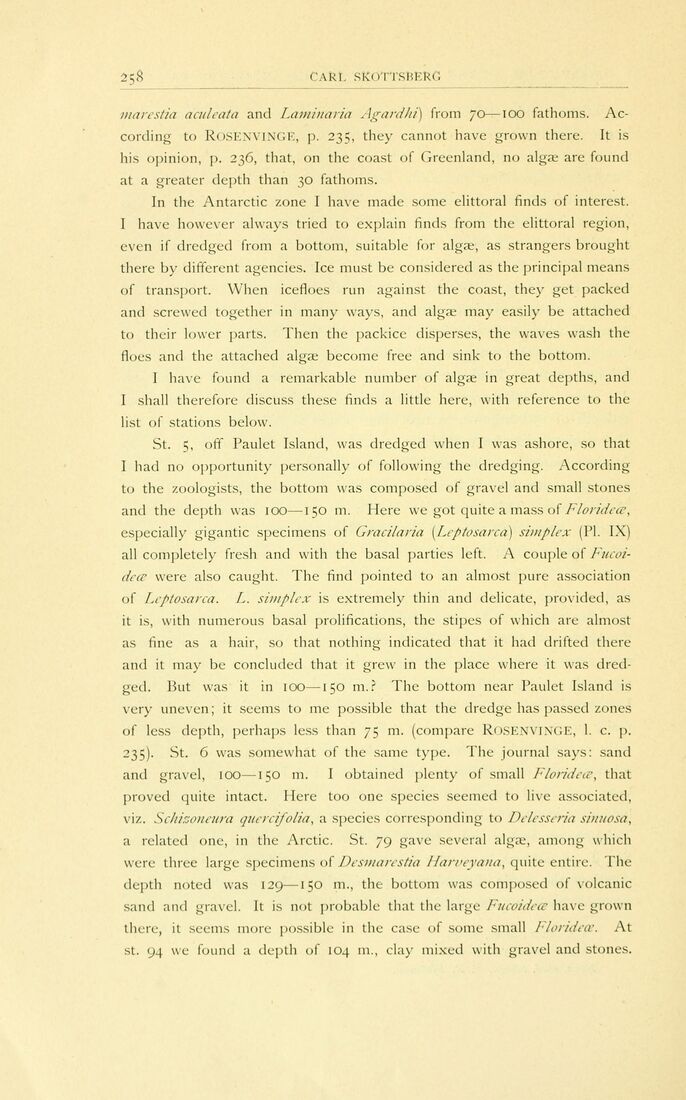
Full resolution (JPEG) - On this page / på denna sida - Sidor ...

<< prev. page << föreg. sida << >> nästa sida >> next page >>
Below is the raw OCR text
from the above scanned image.
Do you see an error? Proofread the page now!
Här nedan syns maskintolkade texten från faksimilbilden ovan.
Ser du något fel? Korrekturläs sidan nu!
This page has never been proofread. / Denna sida har aldrig korrekturlästs.
Carl skottsberg
marestia aculeata and Laminaria Agardhi) from 70—100 fathoms.
According to Rosenvinge, p. 235, they cannot have grown there. It is
his opinion, p. 236, that, on the coast of Greenland, no algæ are found
at a greater depth than 30 fathoms.
In the Antarctic zone I have made some elittoral finds of interest.
I have however always tried to explain finds from the elittoral region,
even if dredged from a bottom, suitable for algæ, as strangers brought
there by different agencies. Ice must be considered as the principal means
of transport. When icefloes run against the coast, they get packed
and screwed together in many ways, and algæ may easily be attached
to their lower parts. Then the packice disperses, the waves wash the
floes and the attached algæ become free and sink to the bottom.
I have found a remarkable number of algæ in great depths, and
I shall therefore discuss these finds a little here, with reference to the
list of stations below.
St. 5, off Paulet Island, was dredged when I was ashore, so that
I had no opportunity personally of following the dredging. According
to the zoologists, the bottom was composed of gravel and small stones
and the depth was 100—150 m. Here we got quite a mass of Florideæ,
especially gigantic specimens of Gracilaria (Lcptosarca) simplex (Pl. IX)
all completely fresh and with the basal parties left. A couple of
Fucoi-dece were also caught. The find pointed to an almost pure association
of Lcptosarca. L. simplex is extremely thin and delicate, provided, as
it is, with numerous basal prolifications, the stipes of which are almost
as fine as a hair, so that nothing indicated that it had drifted there
and it may be concluded that it grew in the place where it was
dredged. But was it in 100—150 m.? The bottom near Paulet Island is
very uneven; it seems to me possible that the dredge has passed zones
of less depth, perhaps less than 75 m. (compare Rosenvinge, 1. c. p.
235). St. 6 was somewhat of the same type. The journal says: sand
and gravel, 100—150 m. I obtained plenty of small Florideæ, that
proved quite intact. Here too one species seemed to live associated,
viz. Schizoneura quer rifolia, a species corresponding to Delesseria sinuosa,
a related one, in the Arctic. St. 79 gave several algæ, among which
were three large specimens of Desmarestia .Harveyana, quite entire. The
depth noted was 129—150 m., the bottom was composed of volcanic
sand and gravel. It is not probable that the large Fucoidece have grown
there, it seems more possible in the case of some small Florideæ. At
st. 94 we found a depth of 104 m., clay mixed with gravel and stones.
<< prev. page << föreg. sida << >> nästa sida >> next page >>